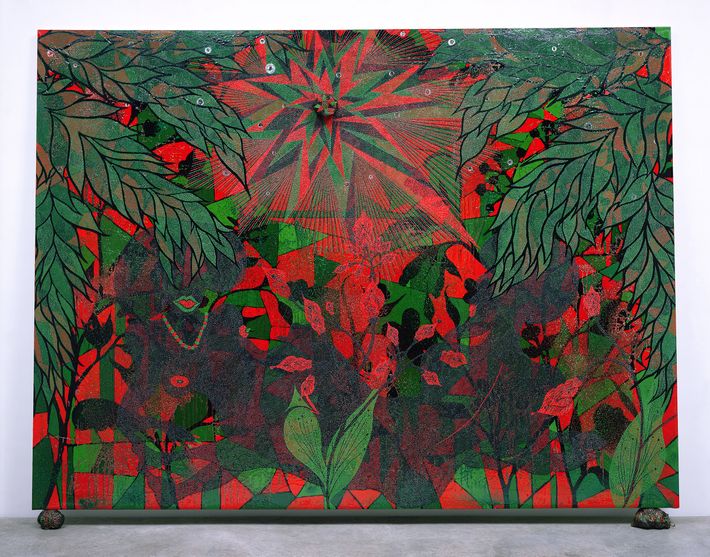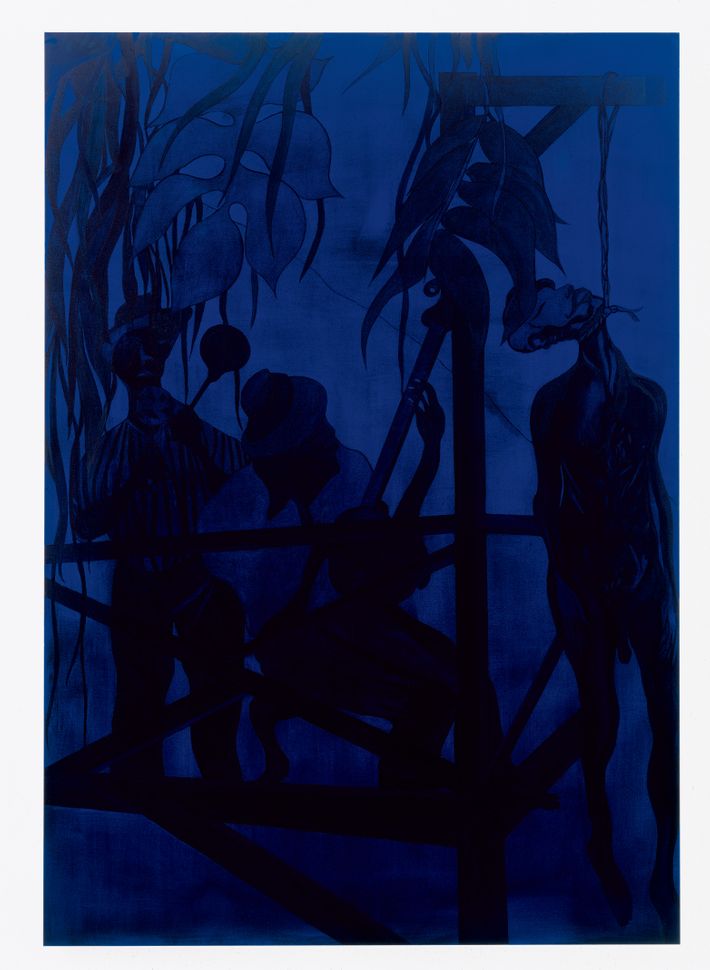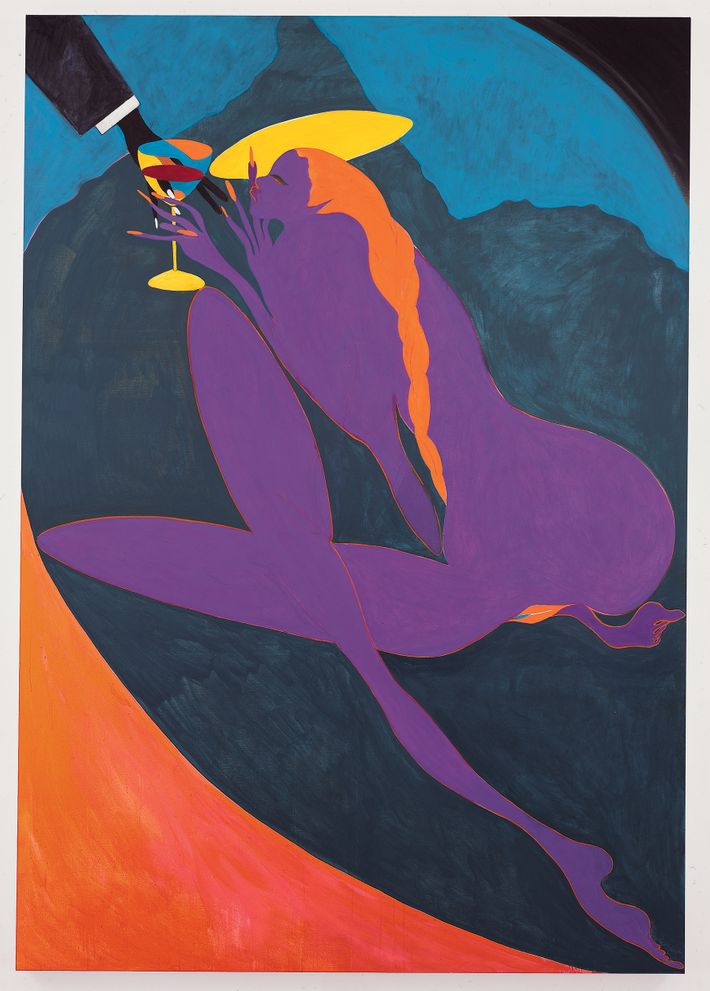
It was a shitstorm that ended in a witch hunt. “If this painting is censored, I’m canceling the show,” snapped English megacollector Charles Saatchi. He said this to me privately in the early hours of September 18, 1999, amidst an exhibition installation at the Brooklyn Museum of Art. Days before, the New York Daily News had run the headline “B’KLYN GALLERY OF HORROR. GRUESOME MUSEUM SHOW STIRS CONTROVERSY.” The “gallery” was the Brooklyn Museum. The “horror” was Sensation, a show of about 40 young British artists from Saatchi’s collection who’d emerged in the early 1990s, most of whom were already fading, making the show seem, to those in the art world, something of a non-event.
Until the Daily News headline. The “controversy” was one painting: Chris Ofili’s beautifully bioluminescent 1996 depiction of a black woman cloaked in cerulean blue. A wavy visage composed of what look like light-emitting microorganisms, she’s surrounded by radiating dots of enamel paint and constellations of small, cutout photographic body parts. Her right breast is fashioned of elephant dung secured to the canvas and decorated with black map-tacks. The painting rests on two dung balls, one festooned with pins that say “Virgin,” the other, “Mary.” Whether it was the visage being black with large “negro lips,” Ofili being black (Nigerian-born, Catholic, and a former altar boy), the body parts in the photos being black, the dung (a material many cultures deem sacred), or the title The Holy Virgin Mary, everything went to hell. Sight unseen, then-mayor Giuliani opined that the dung had been “flung,” called the painting “sick,” and vowed to defund the museum of millions of dollars. The Catholic League objected to the Madonna being “black” and railed over “anuses.” The Jewish Orthodox Union insidiously suggested that the next defacing might “be a Jewish ritual item.” Just one year after the Supreme Court ruled against Karen Finley in her case against the NEA (whose grant to her had been vetoed over “decency issues”), the art world got its shorts in a moralistic twist and, rather than defending Ofili, denounced the museum for colluding with Saatchi to show a private collection in a public institution.
That criticism was, of course, only an alibi. Those in the art world attacking Sensation were motivated by cowardice — and I say that as one of the people who did feel genuinely nervous, so much so that the morning Saatchi made his stand to me, I counseled him toward compromise and placing the painting behind ropes. On December 16, 72-year-old retired teacher Dennis Heiner smeared the painting with white paint. His wife later explained that the white “indicates cleanliness.” As D.H. Lawrence wrote, “The doom is in America … our white abstract end … Doom of our white day … The last phallic being of the white man.”
It is astonishing to consider just how distant the New York of the Sensation era feels now — and that scrappier art world. This is such a nostalgic city, and old-timers so often complain about the romance of the New Yorks of their youths — the ‘80s of Madonna and Basquiat, the ‘70s of Warhol and Blondie, the Cedar Tavern ‘50s — that it can seem no room is left for new excitement, no energy for a culture in which things feel truly up for grabs. Young people now long for every time but their own — and it’s showing, in so much of the derivative 1960s Formalist work.
But the Sensation sensation was only 15 years and one mayor ago. The city was still roiled by white ethnic-identity politics, and the marriage between contemporary art and global wealth not yet consummated (by the art-fair circuit, Damien Hirst, and the High Line); the result being that fully half of New York could still become enraged by the audaciousness of contemporary art for simply daring to be contemporary art.
But hurrah! An exorcism of the bad magic of 1999 has now finally arrived, in the form of the New Museum’s breathtaking building-filling Chris Ofili survey. Night and Day, as the show is called, is an endlessly sensuous dive into the most carnival-esque pleasures of painting. This exhibition makes three things clear. First, Ofili is one of the best painters to have come out of England in the last 60 years. For me, he puts painting through far more enticing paces than Lucien Freud or Francis Bacon. Next, this survey gives the lie to the then-prevalent, always-returning, canard that “painting is dead.” As much as anyone working today, Ofili shows how endlessly expandable painting is, how asinine it is to act like a coroner talking about the death of a medium, or to say that painting can’t be “political” when Ofili is as political a painter as any so-called “activist artist.” Finally, Night and Day reminds us how unlikely this sort of cultural-political crossfire is in our time of art and money flagrantly sleeping together. It’s very hard for art to be that threatening when it’s so empowered.
Although Ofili, 46, is considered a YBA (young British artist), he actually emerged a step after and a painterly sensibility away from the ironic neo-conceptualism of many of the other British artists. He didn’t even have his first show in a bigger London gallery until 1996 — after his fabulous 1995 New York debut — after Hirst and the others were showing worldwide. Everything in Ofili’s early work is keyed up, on optimum optical overload. (He does share this frontal graphic attack with many of the other British artists.)
Start with the bacchanalia early work on the museum’s second floor — bedazzling paintings that come at you with the flamboyant lateral waggle of a swaggering pimp. Canvases here are so layered and dense with dotting, vibrating waves of paint, wild color, washes, and surface inflection that they’re thumping visual equivalents to Sun Ra’s incredible sonic arks. Note the Funkadelic, blaxploitation-like titles: Afronirvana, Monkey Magic — Sex, Money, and Drugs, and The Adoration of Captain Shit and the Legend of the Black Stars. The Holy Virgin Mary is here exuding seductive voluptuousness, mad pizzazz. Racy, raucous, shimmery, Pimpin’ Ain’t Easy depicts an erect brown penis with a smiling face and googly eyes bouncing around a tricked-out iridescent field. Enormous portraits of black goddesses make you aware that there aren’t many personages that look like this in Western museums. And all these paintings rest on dung. As does No Woman, No Cry, a picture of a woman, Doreen Lawrence, crying for her son Stephen, who’d been stabbed to death in South London. All this is the work of a supremely confident, incredibly skilled artist able to activate and control every millimeter of surface so that it throbs with crazed Blakean energy.
Everything changes when you leave the spear-tipped, high-voltage energy of the second floor and arrive on the darkened third. Here is where you begin to understand the show’s title. Eight paintings made since 2006 are installed in a large, gray-carpeted, dimly lit octagonal gallery, paintings that bring Ofili from the gaudy neon city night of the early work to thickets of deep indigo, ultramarine, silver, and black. Hues and values are so close, the eye has trouble making anything out; Ofili allows the imagination to see as much as the eye. Interestingly, the best way to see this work is from oblique angles and with sidelong glances. Iscariot Blues is a black body hanging from a gallows with a banjo player nearby. Spanish moss dangling at the painting’s edges lets Billie Holiday’s “Strange Fruit” coil around Judas’ suicide and what James Baldwin called “the Negro’s past, of rope, fire, torture, castration.” These paintings are so different from what came before that we have to ask why Ofili, when riding so high, would change paths. “At some point I was going to reach a dead end,” he said about his early work. “I had to get off the horse … and walk … That’s what I decided to do.” Many artists facing this sort of daunting change just keep making what they always make. That Ofili could cast painting into such a powerful somnambulant fugue state after doing what he’d done so vibrantly for ten years is a testament to his talent and control.
But just wait. It turns out that, during those years, not only did Ofili change one modality of his painting — going from psychedelic to somber — he changed another at the same time, as is seen in the huge treat awaiting viewers on the fourth floor: an incredible walk-in installation involving nine paintings all done after 2005, when Ofili left England behind and relocated with his family to Port of Spain, Trinidad. In a serene floor-to-ceiling-painted room of violet, pink, and purple flowers, ferns, and trees — it’s like a surround Monet — we see Ofili unleashing all his painterly powers, tapping into art-historical sources as varied as Art Nouveau, Romare Bearden, Jacob Lawrence, Bob Thompson, German Expressionism, Gauguin, and Matisse. The lights are back on in this work, but switched from the electricity of the early work to something alien and natural at the same time. This is Ofili fashioning his own history of art; one that shows Modernism’s warring mode of movements successively killing one another in order to live is less effective than letting all and any art live within one’s work. That is the big change from 1999 — artists are free of the cant. If they want to be and have the nerve.
Let’s end at the beginning, where all ends actually begin. November 20, 1995, the night before the opening of Ofili’s first solo show in the U.S., at Gavin Brown Gallery. That evening around 8 p.m., I drove past Brown’s little Broome Street storefront. I saw something so startling, it made me pull over, stop, stare, and take pictures. Outside the gallery, a painter with his back to me worked on a large vertical painting leaning against the gallery facade. Placing little dots across the surface, he diligently worked with different brushes in his hand, water buckets and other things on the sidewalk all around him. A light might have been propped up as well. I sat transfixed, watching something wonderful come into being, It is simply not possible not to count him among the greatest artists alive.



*This article appears in the November 3, 2014 issue of New York Magazine.

